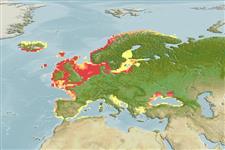Environment: milieu / climate zone / depth range / distribution range
Ecología
marino; salobre demersal; rango de profundidad 1 - 96 m (Ref. 57178). Temperate; 72°N - 36°N, 23°W - 42°E
Northeast Atlantic: Murmansk to Spain, including Iceland and the Baltic (Ref. 4674). Reports from the Mediterraneanare misidentications (Ref. 125963). Two distinct but often sympatric spawning groups exist in the area but have not been given subspecies status although spawning groups differ in mean vertebral number (autumn higher than spring), otolith structure, and probably habitats.
Length at first maturity / Tamaño / Peso / Age
Maturity: Lm 13.0, range 11 - 15 cm
Max length : 20.0 cm SL macho / no sexado; (Ref. 3397); edad máxima reportada: 7 años (Ref. 729)
Espinas dorsales (total) : 0; Radios blandos dorsales (total) : 49 - 58; Radios blandos anales: 24 - 32; Vértebra: 60 - 68. Scales present in the midline anterior to dorsal fin and over the musculature at base of caudal fin. Belly scales in tight chevron. Margins of dorsal and anal fins straight with rays of equal length. Lateral line pores linearly arranged along the un branched canals. Back typically sandy brown.
Territorial; found in inshore waters, especially sandy bays and beaches, including the inter-tidal zone and estuaries; rarely offshore. Alternate between lying buried in the sandy substrate and swimming in schools in the water mass. Adults feed on zooplankton and some large diatoms (Ref. 3397). They hibernate in winter buried in sand at depths of 20-50 cm (Ref. 35388).
Bauchot, M.-L., 1987. Poissons osseux. p. 891-1421. In W. Fischer, M.L. Bauchot and M. Schneider (eds.) Fiches FAO d'identification pour les besoins de la pêche. (rev. 1). Méditerranée et mer Noire. Zone de pêche 37. Vol. II. Commission des Communautés Européennes and FAO, Rome. (Ref. 3397)
IUCN Red List Status (Ref. 130435: Version 2024-2)
Threat to humans
Harmless
Human uses
Pesquerías: muy comercial; carnada: usually
Herramientas
Special reports
Download XML
Fuentes de Internet
Estimates based on models
Preferred temperature (Ref.
123201): 7.3 - 13.5, mean 10.2 °C (based on 738 cells).
Phylogenetic diversity index (Ref.
82804): PD
50 = 0.5156 [Uniqueness, from 0.5 = low to 2.0 = high].
Bayesian length-weight: a=0.00240 (0.00187 - 0.00308), b=3.02 (2.96 - 3.08), in cm total length, based on LWR estimates for this species (Ref.
93245).
Nivel trófico (Ref.
69278): 3.1 ±0.1 se; based on diet studies.
Generation time: 1.8 (1.4 - 2.6) years. Estimated as median ln(3)/K based on 10
growth studies.
Resiliencia (Ref.
120179): Medio, población duplicada en un tiempo mínimo de 1.4-4.4 años (K=0.45-0.77; tm=1-3; tmax=7).
Prior r = 1.02, 95% CL = 0.67 - 1.53, Based on 6 full stock assessments.
Fishing Vulnerability (Ref.
59153): Low vulnerability (23 of 100).
Nutrients (Ref.
124155): Calcium = 80.7 [45.2, 182.6] mg/100g; Iron = 0.528 [0.273, 0.948] mg/100g; Protein = 19.2 [17.7, 20.6] %; Omega3 = 0.459 [0.238, 0.845] g/100g; Selenium = 12.4 [5.5, 29.2] μg/100g; VitaminA = 20.7 [6.7, 66.3] μg/100g; Zinc = 0.857 [0.585, 1.270] mg/100g (wet weight); based on
nutrient studies.
